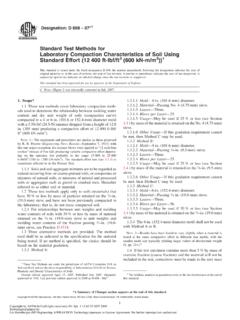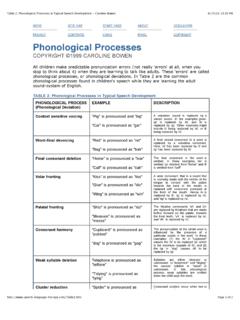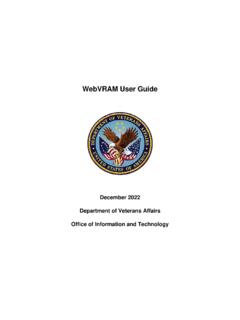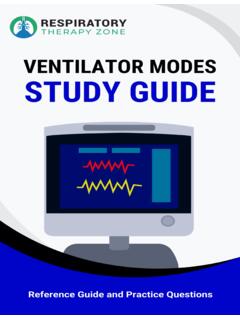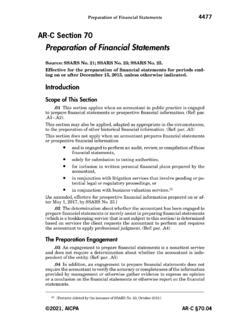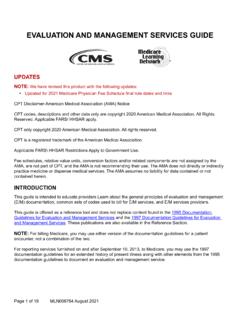Transcription of GUIDELINES ON TAILINGS DAMS - Project Update
1 GUIDELINES ON. TA I L I N G S DA M S. PLANNING, DESIGN, CONSTRUCTION, OPERATION AND CLOSURE. MAY 2012. I M P O R TA N T D I S C L A I M E R. To the maximum permitted by law, each of, ANCOLD Incorporated and its Members, the Convenor and Members of the Working Group which developed these GUIDELINES , and the Independent Reviewers of these GUIDELINES exclude all liability to any person arising directly or indirectly from that person using this publication or any information or material contained within it. Any person acting on anything contained in, or omitted from, these GUIDELINES accepts all risks and responsibilities for losses, damages, costs and other consequences resulting directly or indirectly from such use and should seek appropriate professional advice prior to acting on anything contained in the GUIDELINES . Copyright 2012 Australian National Committee on Large dams Incorporated. All rights reserved. This publication is copyright and may not be resold or reproduced in any manner without the prior consent of ANCOLD Inc.
2 ISBN: 978-0-9808192-4-3. Membership of the ANCOLD Working Group Membership of the ANCOLD working group for GUIDELINES for TAILINGS dams - Planning, Design, Construction, Operation and Closure. David Brett, (Convener) Senior Manager, Mine Water and Waste Management - GHD Pty Ltd Imran Gillani Principal Adviser, TAILINGS , Technology and Innovation - Rio Tinto Keith Seddon Technical Manager - ATC Williams Pty Ltd Norm Himsley Consultant and Member - NSW Dam Safety Committee Russ McConnell Manager Containment Systems Department of Environment and Resource Management (DERM), Queensland Dr Gary Bentel Consultant Dr Bruce Brown Chief Adviser, TAILINGS and dams , Technology and Innovation - Rio Tinto Professor Andy Fourie Professor of Civil Engineering - The University of Western Australia Professor David Williams Professor of Geomechanics - The University of Queensland Reviewers John Phillips Principal Engineer - GHD Pty Ltd, Australia Rob Williamson Technical Consultant - Knight Piesold, South Africa Anna Bjelkevik Director TAILINGS Consultants Scandinavia AB, Sweden Harvey McLeod Principal - Klohn, Crippen Berger, Canada The committee wishes to thank all persons who commented on drafts of these GUIDELINES and helped to ensure the coverage was appropriate to current practice at the time of preparation.
3 ANCOLD GUIDELINES on TAILINGS dams Foreword ANCOLD produced their GUIDELINES on TAILINGS much of the original GUIDELINES but with appropriate Dam Design, Construction and Operation in 1999. updating. There is considerable new information on a Since that time the publication has been widely used design for closure and on the use of risk assessment within Australia and internationally where the techniques to assist in design and management. expertise of Australian practice has been recognised. ANCOLD is pleased to make this contribution towards In the ten years since the release of these GUIDELINES safe and cost-effective TAILINGS dams . The work is the there has been a considerable increase in the recognition result of the TAILINGS Dam Sub-committee of ANCOLD. of environmental responsibilities by the mining and I take this opportunity to thank these members for industry and its regulators, particularly in addressing the unselfish contribution of their time and the concept of sustainable mining.
4 This has culminated experience. in Australia with the release of TAILINGS Management . These GUIDELINES are not a design, construction or one of a series of publications outlining Leading operation code, and dams personnel must continue to Practice Sustainable Development Program for the apply their own considerations, judgements and Mining Industry published by the Australian professional skills when designing and managing Government Department of Industry, Tourism and TAILINGS dams . As time goes on there will no doubt be Resources (DITR, 2007). improvement in contemporary TAILINGS dam practice ANCOLD has prepared these new GUIDELINES to and it is intended that these GUIDELINES will be updated provide a single base document that supports the DITR as circumstances dictate. ANCOLD welcomes publication and others like it, with engineering detail comments on these GUIDELINES which will assist with that can be accepted by all relevant government future revisions. authorities and national and international companies involved in TAILINGS dam development, allowing them to undertake design and construction consistent with Neil Blaikie leading industry practice.
5 The new GUIDELINES include Chairman, ANCOLD. GUIDELINES on TAILINGS dams ANCOLD. Table of Contents Scope 1. Introduction 1. TAILINGS Dam v's TAILINGS Storage Facility (TSF) 1. Past Lessons Learnt 1. Sustainable Use of dams for TAILINGS Storage 2. The need for these GUIDELINES 2. Australian Regulations and GUIDELINES 3. Consultations 4. Procedure for TAILINGS Dam Life Cycle Management 4. Definitions 6. Key Management Considerations 9. Selection of Waste Management Strategy 9. Management Strategies 9. General Principles for Above Ground TAILINGS Dam Disposal 9. Risk Management 10. Risk Management Process 10. Risk Assessment 11. Consequence Category 11. Dam Failure Consequence Category 11. Environmental Spill Consequence Category 14. Planning 14. Life of Mine Planning 14. Key TSF Planning Objectives 15. Important TSF Planning Data 15. TAILINGS Management Plan 16. Levels of Planning 16. Preparation of TAILINGS Management Plan 17. Observational approach 18. External (Third Party) Review 19.
6 TAILINGS Storage Methods & Deposition Principles 20. System Components 20. Environmental Protection Measures 20. Overview 20. Protecting the Community 21. Protecting Waters, Air and Land 21. Protection of Fauna 21. Protecting Heritage 21. Delivery 21. Methods of Containment 22. Constructed Storages 22. Self-Stacking TAILINGS 22. Existing Voids 23. Co-Disposal 24. Methods of Discharge and Depositional Strategies 24. Methods of Discharge 24. Depositional Strategies 25. Segregation and Beach Slope 25. Decant Pond 26. Control of AMD (see also ) 26. Discharge to Environment 27. Method of Construction 27. Staged Construction 27. Characterisation and Behaviour of TAILINGS 28. Introduction 28. Physical and Engineering Characteristics 28. Laboratory Testing 28. ANCOLD GUIDELINES on TAILINGS dams Table of Contents Compression/Consolidation Tests 29. Permeability Tests 29. Dust Generation Tests 29. Strength Tests 29. In-situ Testing 30. Field Trials 30. Mineralogy and Chemistry 30.
7 Geochemistry of the Liquid and Solid Components 30. Rheology and Transport of TAILINGS 31. TAILINGS Beaches 31. Design - TAILINGS Storage Capacity and Water Management 32. Design Criteria 32. TAILINGS Storage Capacity 32. Minimum Decant Storage Capacity 32. Non-Release dams - Design Storage Allowance 34. Spillways 35. Non-release dams - Emergency Spillways 35. The Water Balance 36. Stream Management 37. Rainfall Run-Off 37. TAILINGS Decant Water 37. Evaporation 37. Water Recovery 38. Seepage 38. General 38. Predicting seepage quality and quantity 39. Components of a seepage model 39. Monitoring and verification 40. Predicting impact on groundwater 40. Environmental Assimilative Capacity 40. Design Measures to Minimise Seepage 41. Lining of TSFs 41. Drains and Filters 42. Design Embankment 43. Stability Analysis 43. Stability Evaluations 43. Methods of Stability Analyses 43. Loading Conditions 43. Shear Strength Characterisation 44. Earthquake Considerations 44.
8 Acceptable Factors of Safety and deformation 47. Additional Points to Consider 48. Progressive Failure 48. Reliability and Sensitivity Analyses 48. Settlement 48. Durability of Construction Materials 49. Design Report 49. Third-Party Reviews 49. Construction 50. Introduction 50. Supervision and Documentation 50. General 50. Designer 50. Responsible Engineer 50. Quality Control/Quality Assurance 51. Construction Site Management 51. Storage Preparation 52. GUIDELINES on TAILINGS dams ANCOLD. Table of Contents Clearing and Stripping 52. Springs and Permeable Ground 52. Preparation for Liners 53. Foundation Preparation 53. Instrumentation 53. Source of Materials 54. Use of TAILINGS for Construction 54. Perimeter Embankments 54. Hydrocyclones 55. Staged Construction 55. Commissioning 56. As Built Drawings and Construction Report 57. Operation 58. Management and Training 58. Operations Plan 58. Operations, Maintenance and Surveillance Manual 59. Monitoring and Surveillance 59.
9 Embankment Raising 61. Dam Safety Emergency Plan 61. Maintenance 61. Security 62. Closure 63. Sustainable Closure 63. Closure Plan 63. Closure Options 63. Closure Issues 64. Progressive Closure 64. Mine Completion 64. References 65. Appendices 69. Appendix A 69. Appendix B 72. Appendix C 74. Appendix D 75. Figure 1 Procedure for Planning, Design, Construction, Operation 5. Figure 2 Freeboard Definitions 7. Figure 3 Downslope Discharge TAILINGS Dam Princess Creek Dam Queenstown 26. Figure 4 Upslope Discharge (Terrible Gully TSF Ballarat) 26. Figure 5 Flow Sheet for TAILINGS Dam Spillway and Storage Design 33. Figure 6 Flow sheet for seismic stability analysis 46. Figure 7 Management structure for contractor constructed TAILINGS dam 51. Figure 8 Management Structure for Owner Constructed TSF 52. Table 1 Severity Level impacts assessment - summary from ANCOLD Consequence GUIDELINES (2012) 13. Table 2 Recommended consequence category 14. Table 3 Minimum Wet Season Water Storage Allowance - Fall-back method 34.
10 Table 4 Minimum Extreme Storm Storage Fall back method 34. Table 5 Recommended Contingency Freeboards 35. Table 6 Recommended minimum design floods for spillway design and wave-freeboard allowance 36. Table 7 Recommended Design Earthquake Loadings (AEP) 45. Table 8 Recommended factors of safety 47. Table 9 Dam safety inspections levels 60. Table 10 Frequency of Inspection 60. ANCOLD GUIDELINES on TAILINGS dams Scope SCOPE. ANCOLD's charter is to promote and assist in the development of safe and technically appropriate dams . This charter includes a focus on dams used for the containment of TAILINGS and other wastes, which, along with the normal hazards associated with water dams , have the additional potential for major environmental impact if not properly conceived, designed, constructed, operated and closed in an appropriate manner. Introduction verified, validated, or refined, as real data becomes available. This is commonly known as the These GUIDELINES have been produced by ANCOLD to observational approach to design.

